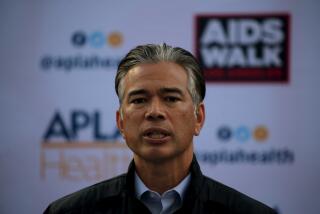Health-Care Is No Longer Sure-Fire Growth Industry
- Share via
For much of this year, investors have been in love with health-care stocks, and for a very simple reason: In a tough economy, health care seemed one of the few sure growth industries.
After all, people still get sick, we’re all getting older and feebler, and most of us don’t pay our medical bills anyway--our employers or insurers do. So what’s to stop the health-care profit train?
The answer to that formerly hypothetical question has been coming home in spades in recent months, as Wall Street has shot down a host of high-flying medical stocks in rapid succession. In each case, the root cause of the stocks’ declines was a sudden concern about eroding profitability--or about the lengths to which the companies must go to ensure decent profit growth.
The latest casualty was Santa Monica-based National Medical Enterprises, whose stock plunged $4.125 to $16.125 Monday, a 20% drop in a matter of hours. The hospital giant disclosed that some of its psychiatric hospitals are under investigation for alleged excessive or fraudulent billing.
The NME news followed the disastrous September earnings report by another psychiatric hospital operator, Community Psychiatric Centers of Laguna Hills. Its shares now trade at $15.75; earlier this year, they were at $40.
Meanwhile, shares of many health maintenance organizations continue to languish after being trounced last summer on profit worries. Cypress-based PacifiCare Health Systems, one of California’s leading HMOs, has seen its stock fall to $26 now from $42.25 in July.
Did something change for all of these companies overnight? Unlikely. Rather, investors simply overpaid for the stocks last summer when they lost sight of an issue that touches us all: As a nation, we can’t afford our medical system anymore. “Growth” in the health care industry will be a relative term from now on.
For years, experts have warned that America’s soaring medical costs would eventually be brought under control, one way or another. And bit by bit, federal and state agencies, insurers and private companies are chipping away at those costs, and thus at the profits of some medical providers.
For example, government and private insurers increasingly are questioning the costs versus the benefits of psychiatric rehabilitation programs, which have become widely used in recent years.
It may well be that the probes into National Medical’s psych hospitals by federal officials in Texas, Florida and New Jersey won’t turn up the overbilling or unnecessary stays that critics of psychiatric programs allege are commonplace. But just the fact that such probes are ongoing shows how health-care costs are seriously under siege.
Consider also the case of Bioplasty Inc., a St. Paul, Minn., maker of breast implants. To encourage more women to undergo such surgery, the company allegedly made false claims about the safety of its implants, the Food and Drug Administration says. In July, the FDA seized a large shipment of the product, stunning investors. Bioplasty’s stock has tumbled to $3.75 now from $19.50 earlier this year.
Stu Roberts, an ace stock-picker who manages the Montgomery Small Cap mutual fund in Denver, figures the FDA now has “a pretty strong mandate” to restrain adventuresome marketing of products that could encourage unnecessary medical spending.
Meanwhile, Sen. David Pryor (D-Ark.) recently launched a salvo against the pricing practices of the nation’s pharmaceutical giants. Pryor, who chairs the Senate’s Special Committee on Aging, contends that drug price inflation in the first half of this year alone ran at an 11.2% rate, or more than three times the general inflation rate.
Throughout the 1980s, drug companies’ profit margins were far above those of the average U.S. industrial company. The drug companies argue that those margins are crucial if the industry is to continue its massive spending on research for new drugs. But Pryor contends the companies show “despicable behavior” in their pricing of drugs.
Whether Pryor will succeed in pushing drug price-control legislation through Congress is far from certain; this isn’t the first time the issue has come up, and the drug lobby is no slouch.
Still, an investor buying most medical stocks today must understand that the angry national mind-set about high health-care costs is a growing threat--especially in a weak economy where few other businesses can raise prices with impunity.
What does that mean for the stocks? For some, not much. Shares of biotech companies will continue to command outrageous prices for the companies’ “miracle drug” potential; other medical firms that actually promise cost savings from new products may also deserve high share prices.
But for many other medical-care providers, perhaps including big drug firms, investors should now be much more sober about the prices they’re willing to pay for the stocks. Annual earnings growth of 15% to 20%, the legacy of the ‘80s, may become 10% to 15% growth in the ‘90s, or less. That’s what the recent plunge in hospital and HMO stocks appears to suggest, and it may turn out to be an early warning for an entire industry.
More to Read
Inside the business of entertainment
The Wide Shot brings you news, analysis and insights on everything from streaming wars to production — and what it all means for the future.
You may occasionally receive promotional content from the Los Angeles Times.








